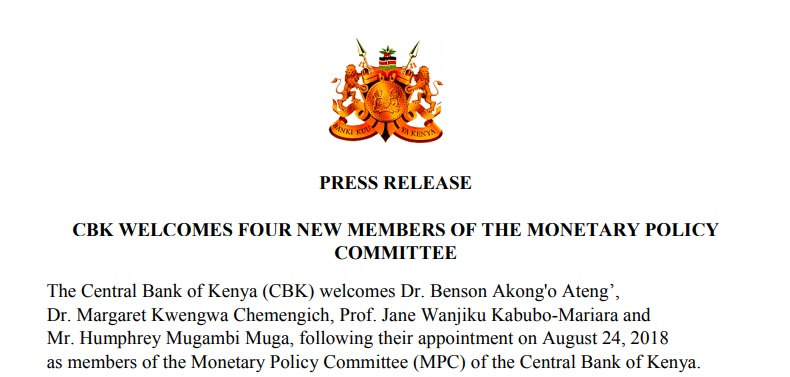When there is a lot of money being supplied in the economy, prices of goods and services increase. This is because there is a lot of money chasing after few goods. As a result, we end up seeing an increase in prices of goods as well as services. When this happens, the Central Banks must take action to mob out excess money from our economy through use of various instruments of Monetary Policy.
Have you ever wondered how the Central Bank of Kenya (CBK) manages to control the amount of money available in the economy? That is what we are discussing in this article.
The process of controlling the amount of money available in an economy is what economists refer to as monetary policy. One of it’s objectives is to maintaining price stability in the economy. On the other hand, price stability is maintaining either low or stable inflation in an economy.
Monetary policy decisions are formulated and implemented by the Monetary Policy Committee (MPC).
Read More: Members of Kenya Monetary Policy Committee (MPC)
The Monetary Policy Committee (MPC) meets at least once every two months to review data as well as analysis from various sources to enable it make decisions.
The main monetary policy instruments are:
a) Reserve requirements
b) Discount Window Operations and
c) Open Market Operations (OMO)
d) Central Bank Rate (CBR)
e) Foreign Exchange Market Operations
Reserve requirements
In Kenya, all commercial banks are required by law to keep a specified share of their total deposits at the Central Bank of Kenya.
This is what they refer to as Cash Reserve Ratio (CRR). When Central Bank want to control the amount of money in the market, they either increase or decrease the ratio.
The Central Bank does not pay interest for the amount held for the Commercial banks.
As we write this article, the law requires that all commercial banks deposit 5.25 percent of their total deposits with Central Bank of Kenya.
Central Bank Rate
Monetary Policy Committee (MPC) reviews and announces the Central Bank Rate (CBR) at least every two months.
To understand the position on MPC, you’ve to look at the size and direction of Central Bank Rate.
Central Bank Rate is the lowest rate that commercial banks can charge their clients. This means that you cannot go below this rate.
When the Central bank rate is reduced by the Monetary Policy Committee, that is a sign that they want commercial banks to lower their interest rates. This action encourages economic growth through increased demand for credit from the banks. This is why economists and other finance professionals say that investment is a function of interest rates.
Foreign Exchange Market Operations
Central banks can control the amount of money in the market by actively participating in the foreign exchange market operations.
When Central Bank sells foreign currency to the commercial banks, this will have an impact of reducing the amount of local currency being in supply. Conversely, when CBK buys foreign currency (dollars, yens, Euro, Swiss Francs or Renminbi among others) it will inject Kenyan currency into the market.
By the way, Central Bank buys foreign current for many reasons and one of them is to use the currency to service foreign debts. For example, if Kenya was give a loan in Euros and it has to service that loan in Euros, then CBK will go to Foreign Exchange market and purchase Euros using Kenyan Shillings. That will effectively increase the amount of local currency in supply.
The second reason why CBK engages in Forex market is to build up its foreign exchange reserves as required by law.
“To maintain foreign reserves equivalent to four months’ imports as recorded and averaged for the last three preceding years. The CBK does not participate in the foreign exchange market to defend a particular value of the Kenya shilling but may intervene in the exchange market to stabilize the market in the event of excess volatility,” Central Bank of Kenya website.
Four members of Monetary Policy Committee (MPC) nominated by the Cabinet Secretary for National Treasury:
- Mr. Humphrey Mugambi Muga
- Professor Jane Wanjiku Kabubo-Maria;
- Dr. Benson Akong’o Ateng;
- Dr. Margaret Kwengwa Chemengich
Monetary Policy Committee

References
Central Bank of Kenya website



One thought on “Instruments of Monetary Policy in Kenya”
Comments are closed.